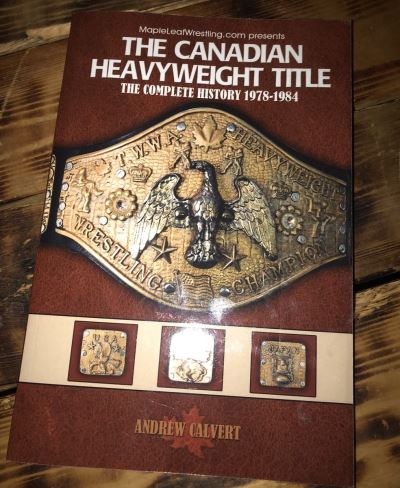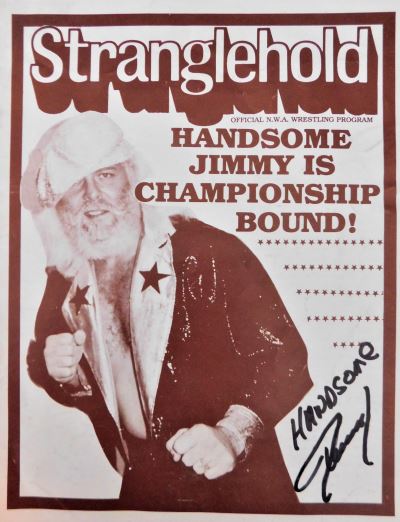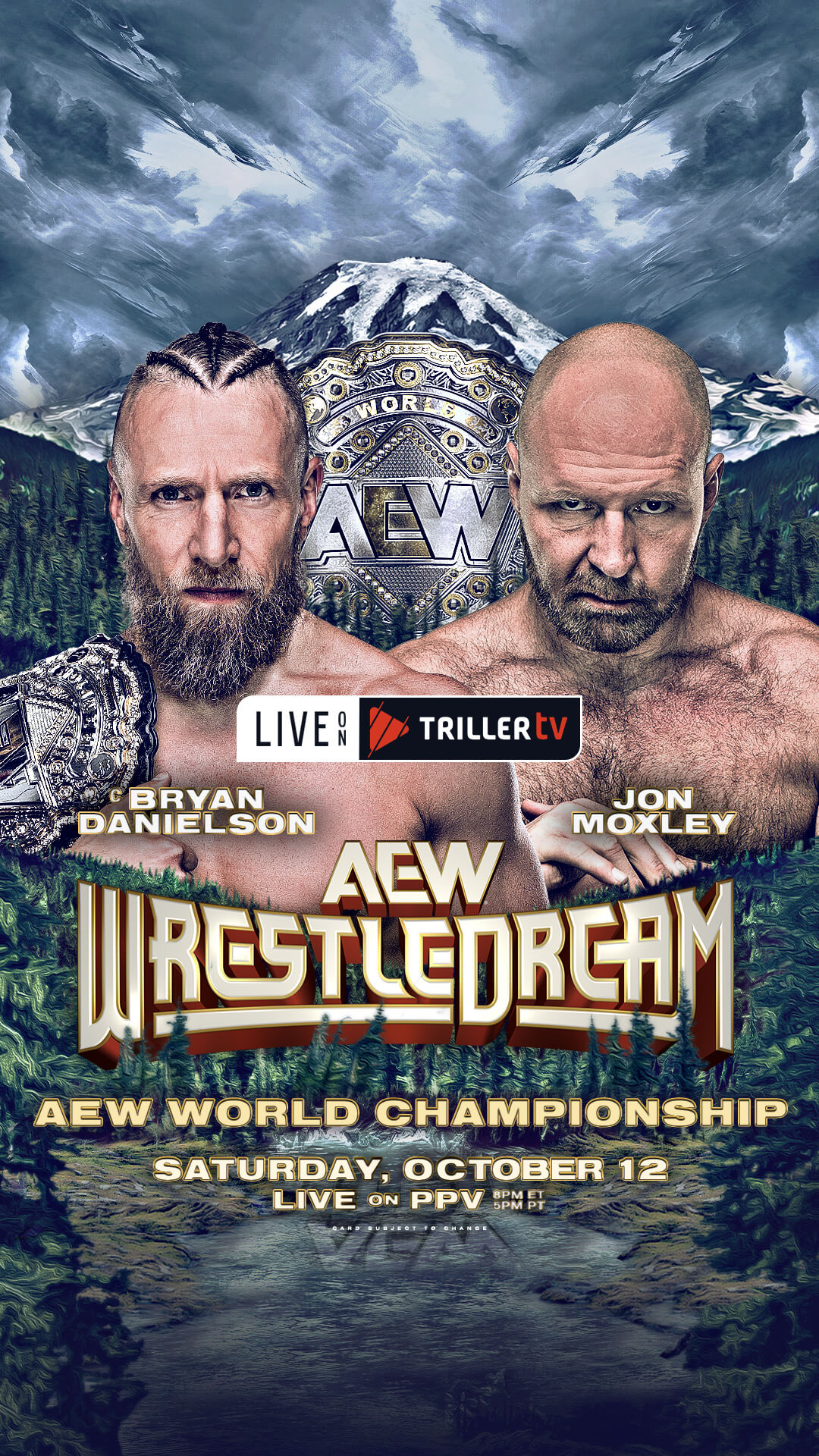My favorite period in wrestling is the Mid-Atlantic era and the Toronto territory of the late ’70s to the early ’80s.
I vividly remember sitting on the edge of my seat in the front row of the Kitchener Memorial Auditorium, seeing greats like Johnny Weaver, Billy Red Lyons, Sweet Daddy Siki, the Great Kabuki, and “Boogie Woogie Man” Jimmy Valiant.
That’s why Andrew Calvert’s new book, The Canadian Heavyweight Title: The Complete History 1978-1984, feels like it was written for fans like me, who long for the glory days of Jim Crockett Promotions and Maple Leaf Wrestling.
In the preface, Calvert writes: “As a youngster there was barely anything more fun than going to a pro wrestling card. It was an alternate universe where the heroes and villains were truly larger than life.

“Living in the suburbs of Toronto, it was always an adventure going downtown to Maple Leaf Gardens. You could wait out on Wood Street behind the arena and watch the wrestlers arrive. Some of them in cabs or other vehicles, some walking over from the Westbury Hotel down the street.
“Soon Norm Kimber would walk up the ramp into the ring and announce in his inimitable tone that the card was starting. The lights would go down for the first bout and you were in another world.”
It’s the story of the Canadian Heavyweight Title in the Toronto territory, which was introduced by promoter Frank Tunney in 1978, and was defended by the top star of Maple Leaf Wrestling.
Calvert, who runs MapleLeafWrestling.com and has contributed to SLAM! Wrestling, sheds light on memorable feuds with champions and challengers like Dino Bravo, Angelo Mosca Sr. and Jr., Greg Valentine, Dewey Robertson, Big John Studd, Hossein the Arab, and many more. Chapter One is a brief historical look at the history of the Toronto territory and its promoters and affiliations, with names like Ivan Mickailoff, Jack Corcoran, The Tunneys (Frank, John, and Jack), Paul Bower, Toots Mondt, and the Sheik.
From Chapter Two on, Calvert takes a deep dive into the history of the Canadian Heavyweight Title, the wrestlers who won it and defended it in Toronto and the circuit towns, and on occasion around North America.
Calvert writes, “When Dino Bravo was awarded the Canadian Heavyweight Title belt in Toronto in 1978, it was the start of a new era. He was not, however the first Canadian champion to wrestle here. Going back to the early days of professional wrestling in Canada there were Canadian champions representing the best in the country — and several of them wrestling in Toronto.
“Before the days of company-mandated champions, the title of ‘Canadian champion’ signified the best Canadian wrestler. He would face opponents all over Canada, the U.S. and even overseas — but could only drop the title by losing to another Canadian wrestler.”
In early chapters, Calvert tells the backstory of Greg and Johnny Valentine’s Toronto legacy, local hero Dewey Robertson, and the Mid-Atlantic connection between Frank Tunney and Jim Crocket Promotions.
And while Maple Leaf Gardens was the cornerstone for Toronto wrestling for over 60 years (1931-1995), I was fascinated to read about the many venues I was unfamiliar with, like Hanlan’s Point, Riverdale Rink, the Labor Temple, and Arena Gardens/Mutual St. Arena in the early days.
Then there was Oakland Stadium, East York Collegiate Memorial Stadium, Maple Leaf Stadium, the CNE Coliseum, Varsity Arena, and Exhibition Stadium, where Night of Champions was held in the Summer of ’83, featuring Ric Flair, Harley Race, Ricky Steamboat and Jay Youngblood, Dory Funk Jr., Jos Leduc, The Fabulous Moolah, Princess Victoria, Wahoo McDaniel, Jake Roberts, and the One Man Gang.
Memories came flooding back reading about the Stranglehold wrestling programs I would pick up for a buck or two at the Kitchener Memorial Auditorium, that included a Maple Leaf Wrestling photo gallery with stars like Goldie Rogers, Nick DeCarlo, and Kurt Von Hess, and line-up sheets where I could record the results of matches and changes to the card.
Illustrated with tons of great photos, wrestling program covers, and newspaper ads for all the big shows, Calvert sheds light on memorable feuds and bloody Texas Death matches, packed with legendary names like the Anderson brothers, Gene Kiniski, Sgt. Slaughter, Blackjack Mulligan, Ron Bass, Leroy Brown, Roddy Piper, Paul Jones, Super Destroyer, Nick Bockwinkel, Tiger Jeet Singh, Abdullah the Butcher, Killer Khan, and Andre the Giant.

An autographed Stranglehold program from Marshall Ward’s collection.
For fans like me who love reading about historical tournaments and results, there are battles over the Canadian championship that include everyone from Carlos Colon, Dick Slater, and the Grapplers to Leo Burke, Ivan Koloff, and Vinnie Valentino.
Then there are unanswered questions and fascinating factoids, as Calvert writes: “On July 12, 1981, Mr. Fuji finally defeated Mosca in a Texas Street fight to win the Canadian title. It would turn out to be the shortest of the title reigns with Mosca winning it back on the very next MLG card just two weeks later. There was a card in Buffalo, NY in between but the results are abbreviated so it’s not clear if Fuji appeared or if the title had been defended. In all the years since we still have not found a photo of Fuji wearing the Canadian title belt.”
But my favorite chapter in the book shares insight into the origins of “the ramp,” an elevated walkway to the ring at Maple Leaf Gardens that, for me growing up, was one of the most memorable and vivid parts of Maple Leaf Wrestling.
It was put in to protect the heels, specifically Nanjo Singh, from the wrath of the fans, Calvert writes in Chapter Nine: “The Title Years.”
“In 1948 when it was first used, the weekly cards were often brought to rioting by the heels of the day. Whipper Watson was in his prime and the star of the show. That made any of his opponents public enemy #1. In particular the dreaded Nanjo Singh.”
Calvert takes the final chapter of the book to answer the compelling question, “So what became of the belt in the years following the switch to the WWF?” The belt was retired in the summer of ’84 when the new Maple Leaf Wrestling was formed during a meeting with Vince McMahon, Hamilton star and third partner in the original 1978 Tunney/Crockett arrangement, George Scott, and Frank Tunney’s son, Eddie, who worked alongside his cousin Jack.
In the epilogue — the most riveting part of the book for me — Calvert laments that “the story of the Canadian Title ends with the beginning of a new age in Toronto wrestling history. Most people describe it as ‘Toronto selling to the WWF,’ but that isn’t accurate.”
A trip down memory lane, The Canadian Heavyweight Title: The Complete History 1978-1984, published in co-operation with the Mid-Atlantic Gateway website, is a remarkable, compelling, and long-overdue tale about a championship belt that shared the stage with some of the most respected titles in professional wrestling history.
RELATED LINK



Hi Marshall, good memories indeed!